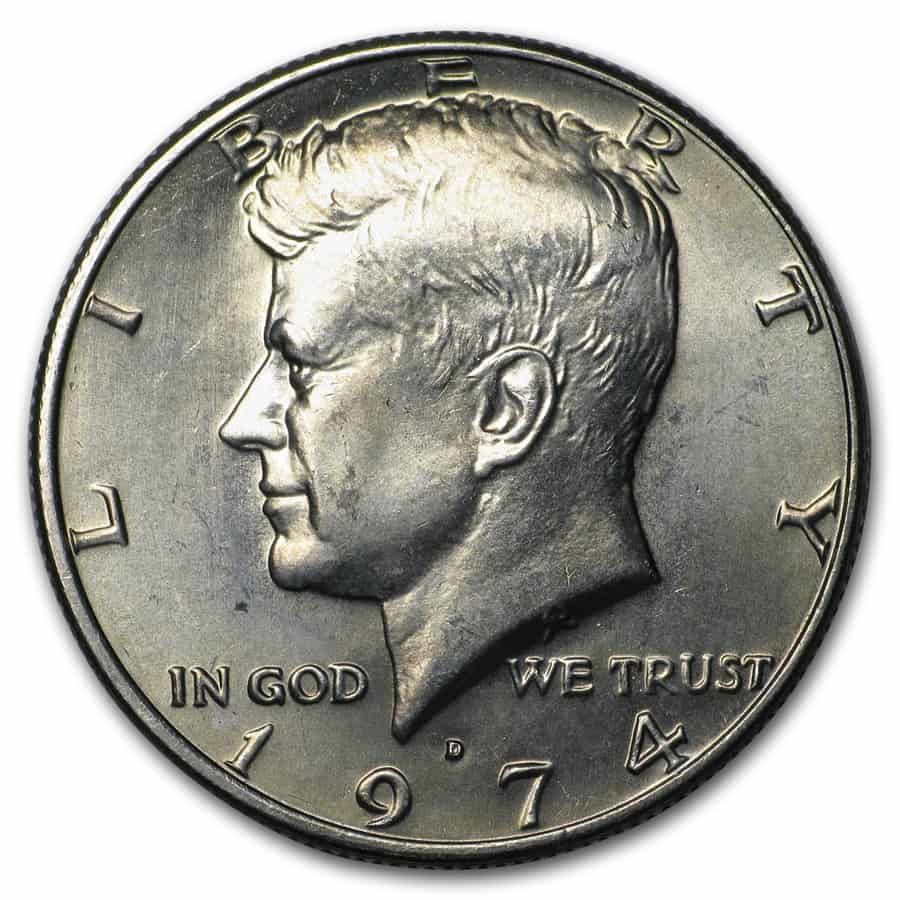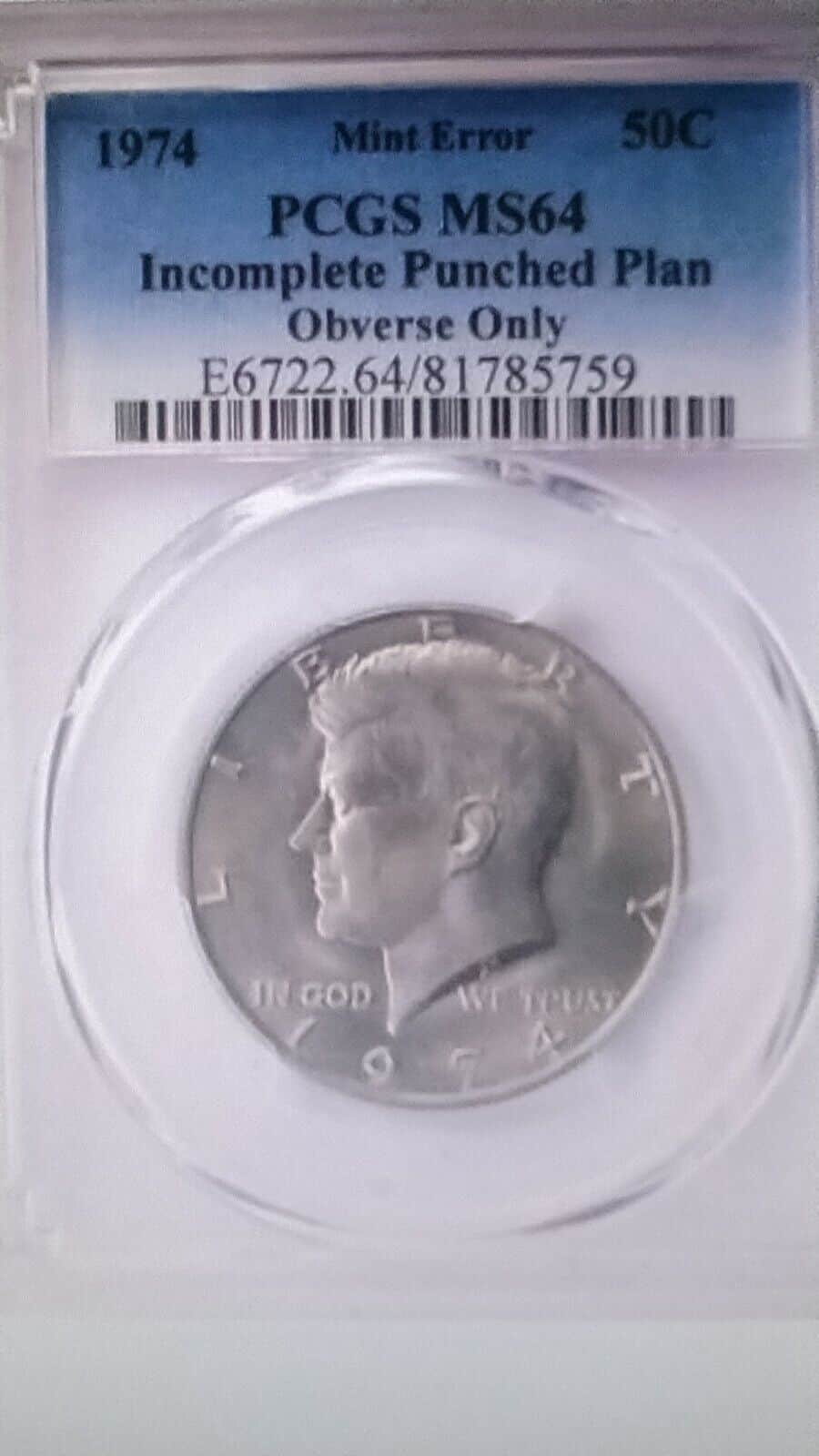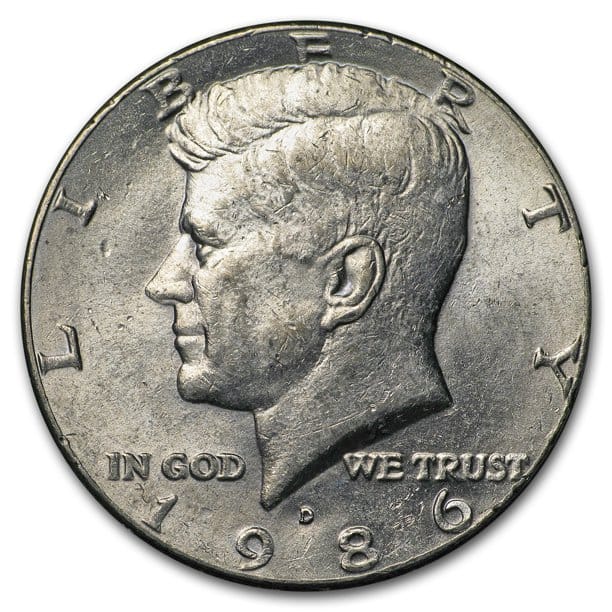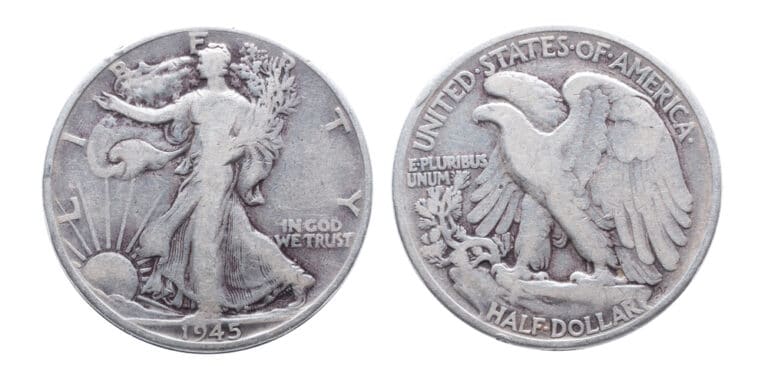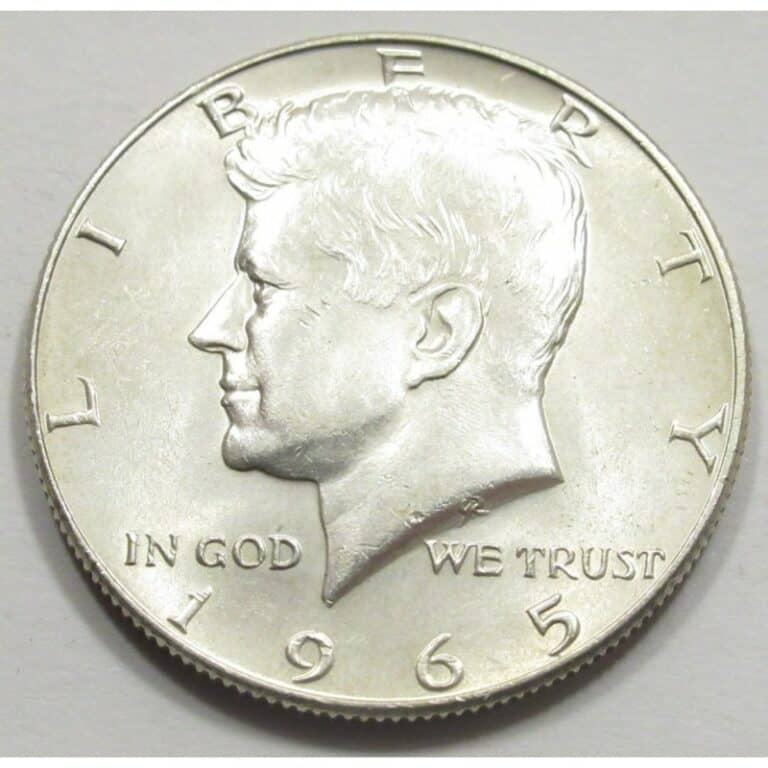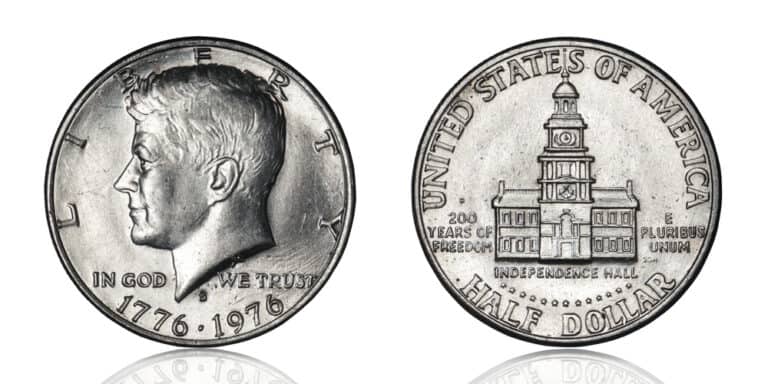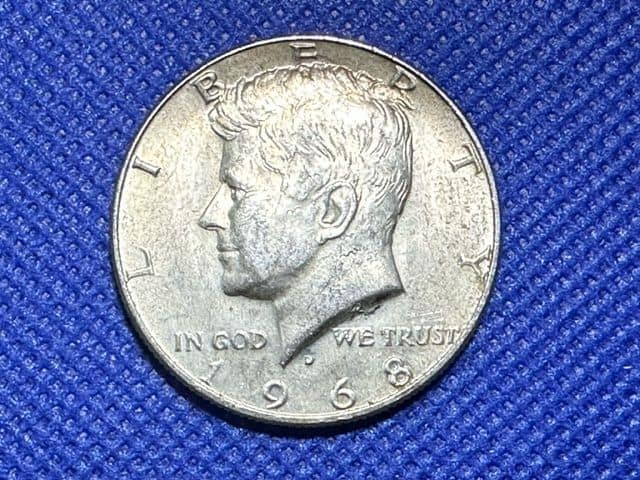1974 Half Dollar Value: How Much is it Worth Today?

1974 was a wild time for politics; President Richard Nixon was embroiled in the Watergate scandal, and in the same year resigned from his post. Despite that, coin mintage didn’t stop: a coin commemorating a president well-loved by the public, the Kennedy half dollar, was still being minted.
In this article, we will be talking about the 1974 half dollar’s value, varieties, grading, rare errors, and questions that you might have regarding the coin!
1974 Half Dollar Value |
||||
| Mintmark | MS60 | MS63 | MS65 | MS67 |
| 1974 No Mint Mark P Half Dollar Value | $1 | $6 | $20 | $2,600 |
| 1974 D Half Dollar Value | $1 | $6 | $20 | $325 |
| 1974 S Proof Half Dollar Value | $1.15 | $2.75 (CA) | $5 (CA) | $2,300 (PR70UC) |
1974 No Mint Mark P Half Dollar Value
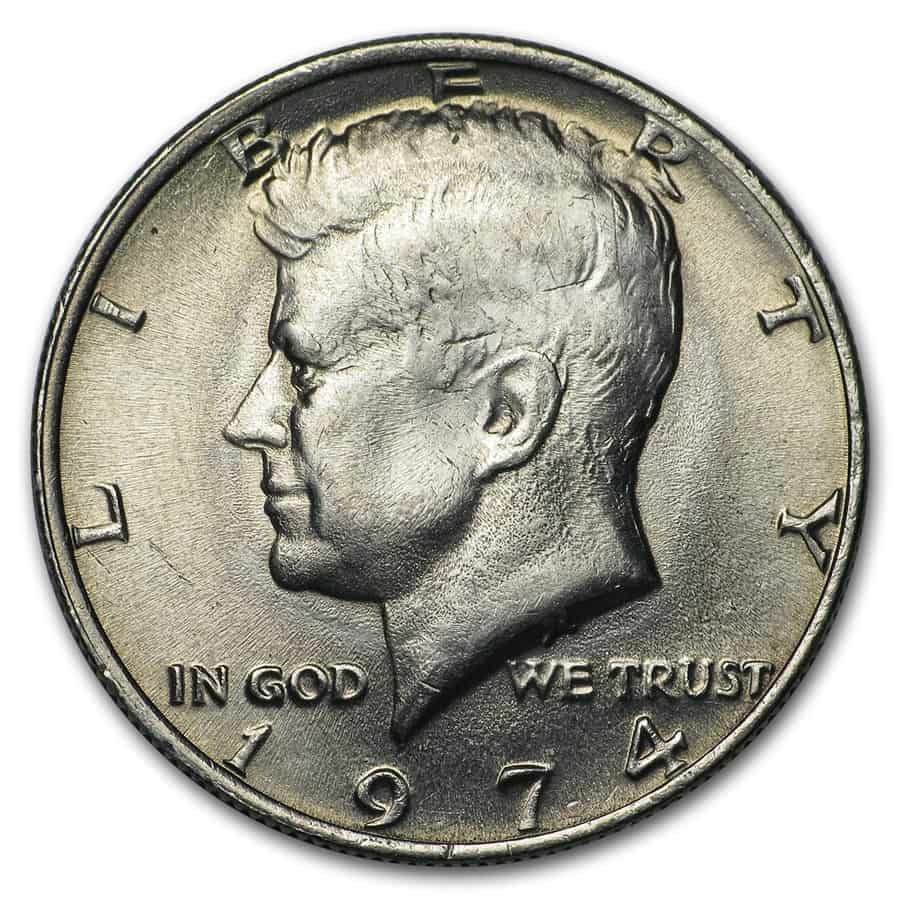
The 1974 no mintmark P half dollar is part of a series of coins called the Kennedy half dollars. Designed to give homage to President John F. Kennedy, the coin was minted and released in 1964, a few months after his assassination.
With over 200 million examples minted, the 1974 P half dollar coin with no mint mark, produced in Philadelphia, is a very common coin. Aside from the fact that it has only been only around 50 years since its release, many half-dollar coins did not join general circulation, saved up by collectors.
It initially started in its original mintage, in which the half dollar coins were made of 90% silver. Aside from collectors and laypeople wanting to keep a memento of the late president, the Kennedy half dollar was hoarded by people who were interested in melting the coin for its silver metal. The government tried to reduce the amount of silver from 90% to 40% in 1965, but to no avail.
Eventually, in 1970, they changed the composition into a copper-nickel cladding with a copper core. Unfortunately, this move still failed to introduce the half dollar back into common use and circulation. Despite being a coin still being issued by the US Mint, the half dollar became an obsolete coin in American currency, and coins currently being minted are designed for collectors and not for circulation anymore.
Because of these circumstances, the 1974 half dollar coins are readily available across all grade conditions. Coins in uncirculated grades are plentiful and common, so you shouldn’t have a hard time starting a collection that includes this issue. Although higher-quality gems starting at MS66 can become quite scarce, grades below that are a non-issue to find.
The 1974 P half dollar can be found at MS60 for only $1, and even gem examples at MS66 are being sold for $80. However, higher-quality gems, like MS67 specimens and higher, are still pretty scarce, and you’ll have to shell out $3,000 for an MS67+ coin.
The current auction record price for this coin is $8,000 for an MS68 piece.
1974 D Half Dollar Value
The Denver Mint had a busy time around the 1970s. To meet the increasing coinage demands of the country, the government has decided to construct a new Mint in Denver. The initial site chosen for this new Mint was found along the South Platte River.
However, discussions with the Burlington Northern Railroad Company revealed that the company was also interested in building railroad tracks adjacent to this area. Later on, the Mint Director at the time, Mary T. Brooks, announced that they had settled on an area found on the Clayton Trust Property in the Park Hill area.
Aside from these developments, the Denver Mint was also busy with the preparations for the 1975/76 Bicentennial coins in celebration of 200 years of the United States of America’s establishment as an independent republic. Hence, it is quite the feat for the Mint to have produced over 79 million pieces for the 1974 issue, given its other activities.
The 1974 D half dollar suffers a similar fate to the 1974 P half dollar: an extremely high mintage of a little over 79 million pieces yet a small fraction of those entering general circulation. Despite having no more silver melt value anymore, the established precedent of not utilizing half dollars caused this issue, like many other issues of the half dollar, to have a high survival rate.
While the 1974 P half dollar is plentiful up to the gem grades, the 1974 D is believed to be common up until MS64. At gem grades, their population considerably decreases, although examples should still be readily available. There have been no known specimens above MS67+.
The price curves for the 1974 P and 1974 D half dollar are quite similar: both start at $1 for an MS60 piece, then reach $20 for the first gem grade MS65. Higher gem-grade specimens become scarce beyond that first point, and an MS67+ example would cost you $2,500.
The current auction record price is $2,468 for an MS67+ coin.
1974 S Proof Half Dollar Value
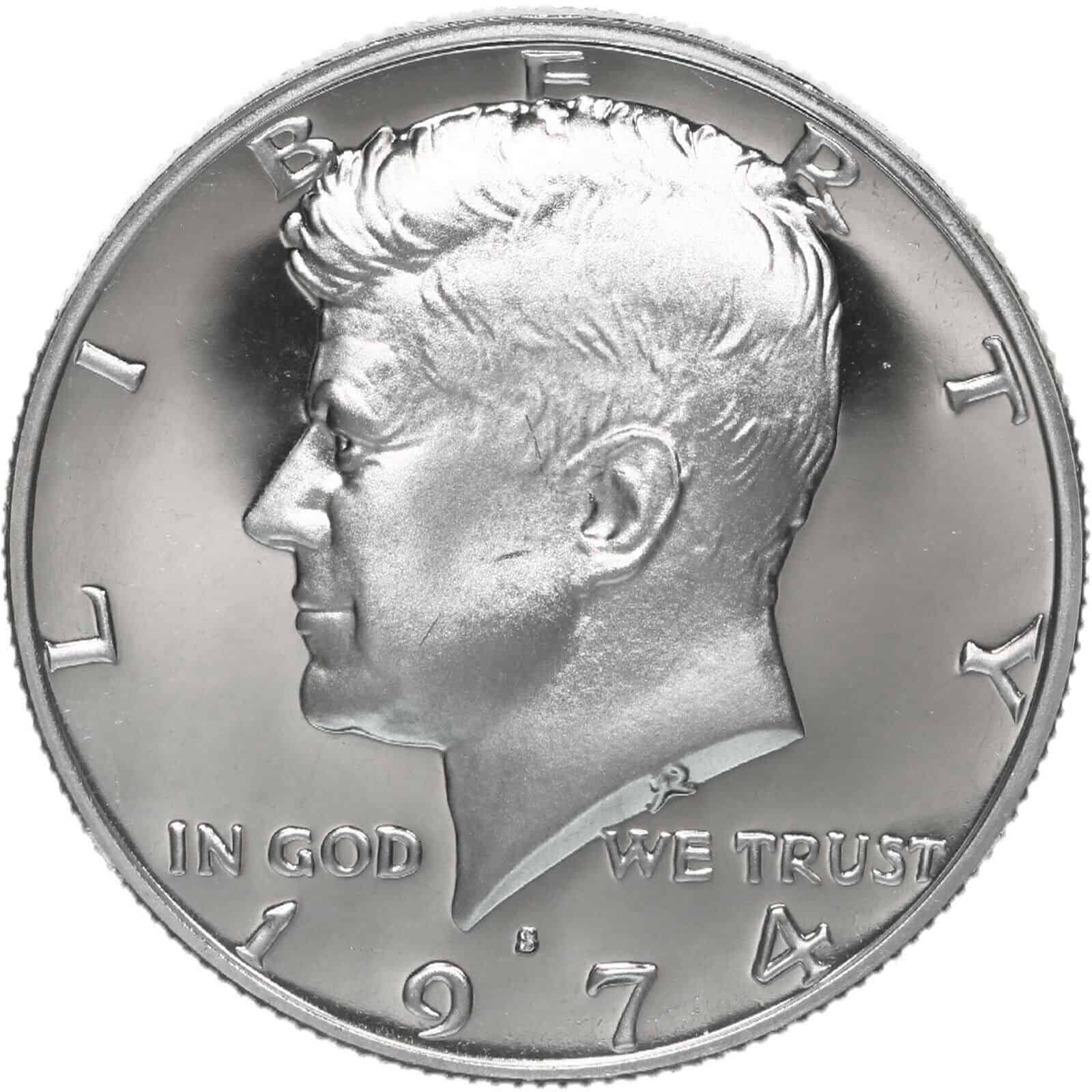
The San Francisco Mint, officially the San Francisco Assay Office before 1988, took over the production of proof coinage from the Philadelphia Mint starting from 1968. However, 1974 was the last year when they released circulation-strike coins. By 1975, San Francisco-mintmarked coins were almost exclusively proof coins, except for certain coins.
For the 1974 issue, over 2 million pieces were minted in the San Francisco Mint, all of them proof coins with the S mintmark. Given that these proof coins were mostly sold to collectors, these coins have a high survival rate.
Proof coins are also generally sold at a generally low price, despite the high quality of these coins, because their make is more susceptible to losing their high quality once exposed. However, most proof coins are very well-kept to preserve their luster.
Proof coins are also further categorized depending on the cameo contrast on the coin. The Cameo designation is given to coins with a moderate frosted relief, while the Deep Cameo (PCGS) or Ultra Cameo (NGC) designation is given to coins with a very strong cameo effect, with a strong frosted relief and reflective field.
Additionally, PCGS recognizes several varieties of the 1974 S proof half dollars. There are three Signature Series varieties for this issue. The signatories are often prominent figures in the numismatic industry. They hand-signed the labels of some 1974 S proof Kennedy half dollars, increasing the value and prestige of that coin.
Thomas S. Cleveland is an American artist who served as a Master Designer in the Artistic Infusion Program of the US Mint from 2004 to 2014. Joe Orlando was the Chief Executive Officer of Collectors Universe, the parent company of PCGS, until 2021. Miles Standish was the Vice President of NGC, the official grading service of the American Numismatic Association.
1974 S half dollar coins are generally more expensive than low-grade circulation-strike 1974 P and D coins, with a PR60 coin starting at $1.15. However, aside from DCAM/UC varieties, their price curves are different, with a PR69 specimen coming at only $22.50 and a PR69CA coming at $25. However, if you can manage to snag a PR70UC, you can sell it for $2,300.
The current auction record price is $7,931 for a PR70DCAM piece.
1974 Half Dollar Grading
The 1974 half dollar is often judged according to the Sheldon coin grading scale. This numerical scale starts with 1, for the worst quality, and ends at 70, for the best quality. Aside from the number, there are also qualitative descriptions, such as Good, Fine, and Uncirculated.
Rare 1974 Half Dollar Error List
1974 Half Dollar DDO Error
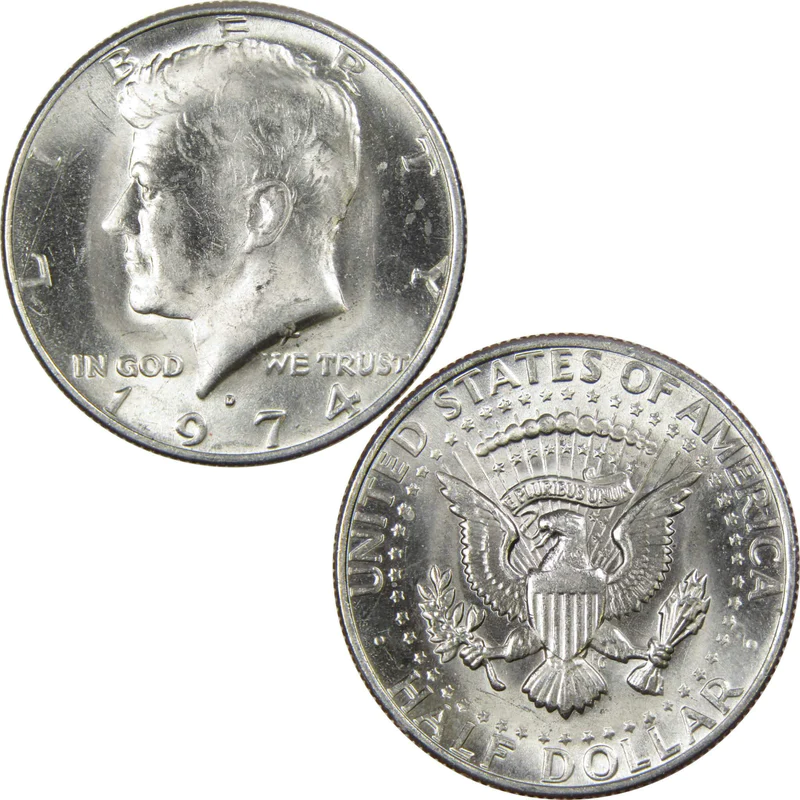
A doubled die error occurs during the manufacturing process of the coin dies. Hubs are used to transfer the design of the coin onto the die, which will then be used to place the design onto the coin. When subsequent punches on the hubbing process are misaligned, they create a duplicate design on the die. These designs are then also transferred to the coins themselves.
Across the entire Kennedy half dollar series, the 1974 issue is the only one with the most prominent doubled die error, found on the obverse of the 1974 D half dollar coins. The error can be most clearly seen on the words IN GOD WE TRUST, placed on either side of Kennedy’s bust on the obverse of the coin.
The current auction record price for a coin with this error is $575 for an MS66 specimen.
1974 Half Dollar Die Break Error
Another kind of die error is the die break error. This error is simply the result of a die’s natural wear and tear as it is constantly being used to produce coins. A die break occurs when a part of the die breaks, which is then impressed into the coin. Usually, the die would be replaced once it reaches its end-of-life, but some coins produced by this damaged die go into circulation.
A die break may be pretty easy to fake, since chipping off a small part of the relief may look like a die break, too. However, sending the coin to a reputable coin grading agency will help you identify if the coin and the error are genuine.
A 1974 Kennedy half dollar was found with a die break error. Some places to look for are the stars on the reverse of the coin, right under the word UNITED. This coin is still being bidded on, starting at $6.
1974 Half Dollar Incomplete Planchet Punch Error
The incomplete planchet punch error is a slightly different error than doubled dies. While the previous errors are die errors, the incomplete planchet punch is a planchet error, which occurs earlier in the coin-making process, when the coins are being cut off into circles from a metal strip.
As the metal strip is being fed into the blanking press (rightly called since it produces blank coins), a circular cutting tool punches through the strip to create the blanks then the press moves the strip across to punch the next section. However, there are instances when the press doesn’t move the strip far enough, and the punch instead pushes through an already-punched section of the strip.
The blanks on that section will exhibit this error. You can see this error by trying to find a crescent mark on the coin. A 1974 P half dollar was found with this incomplete planchet punch error on the obverse, selling for $198.
1974 Half Dollar FAQ
Is a 1974 half dollar rare?
The 1974 half dollar coin is not a rare coin; in fact, it is considered to be a very common coin. Back when the half dollar was new, people hoarded it for various reasons (melting early coins for silver, keeping a memento of the late President Kennedy), which pushed the coin out of circulation.
Even when the reasons for hoarding these coins faded over time, people seemed to have gotten used to not having half dollar coins in circulation. Eventually, half dollar coins were being minted solely for collectors.
The hoarding is also one of the reasons why the 1974 half dollar is common; many people were able to keep their own coins with them, avoiding these coins from being worn down and reduced by circulation.
How much is a 1974 D half dollar error worth?
Despite the Denver Mint producing less than half the mintage of the Philadelphia Mint in 1974, their D half dollar coins are worth the same as the P half dollar coins. You can get an uncirculated coin for merely $1, and gem examples start at $20. An MS67 coin will cost you $325 before the next tier, MS67+, demands at least $2,500 from you.
Is a 1974 half dollar real silver?
Although early issues of the Kennedy half dollar, from 1964 to 1970, had silver on them, the 1974 half dollar does not have real silver. The 1974 half dollar has a cladding made of 75% copper and 25% nickel, wrapped around a core of pure copper. This change was done to prevent people from hoarding these coins, although this problem was never truly solved.
What does FG mean on a 1974 half dollar?
The letters FG on a 1974 half dollar stand for Frank Gasparro. Frank Gasparro was the US Mint’s Assistant Engraver and later on Chief Engraver. He designed the reverse of the Kennedy half dollar, based on the reverse of a medal, in which the obverse was designed by Gilroy Roberts, who also designed the obverse of the half dollar.
You can see the letters FG right in between the eagle’s tail and right leg.
